ACRONYM Voter Registration
ACRONYM Voter Registration
ACRONYM Voter Registration
ux/ui design
information architecture
wireframing
interactive prototypes
visual design
illustration
Expanding the electorate with voter registration, relational organizing, and mobilization tactics
Expanding the electorate with voter registration, relational organizing, and mobilization tactics

about
ACRONYM is a nonprofit organization committed to building power and digital infrastructure for the progressive movement.
ACRONYM is a values-driven organization focused on advancing progressive causes through communications, advertising and organizing programs. They run targeted media programs to educate, inspire, register, and mobilize voters.
ACRONYM is a nonprofit organization committed to building power and digital infrastructure for the progressive movement.
ACRONYM is a values-driven organization focused on advancing progressive causes through communications, advertising and organizing programs. They run targeted media programs to educate, inspire, register, and mobilize voters.
overview
overview
overview
In America, there's a significant disparity in votes cast between BIPOC and white people, as well as in young versus older age groups. This leads to a country whose leaders skew more heavily towards the interests of a whiter, older demographic, rather than those representing the interest and needs of America's diverse electorate.
The project’s initiative aimed to encourage these voters to register to vote and show up at the polls for the November 2020 election. We targeted young, BIPOC constituents living in swing states. The landing page traffic was generated primarily by paid social media campaigns.
In America, there's a significant disparity in votes cast between BIPOC and white people, as well as in young versus older age groups. This leads to a country whose leaders skew more heavily towards the interests of a whiter, older demographic, rather than those representing the interest and needs of America's diverse electorate.
The project’s initiative aimed to encourage these voters to register to vote and show up at the polls for the November 2020 election. We targeted young, BIPOC constituents living in swing states. The landing page traffic was generated primarily by paid social media campaigns.
team
For this project, I worked with a Product Manager, two developers, and several external client stakeholders.
research
research
research
users
We determined four different user types, their motivations, needs, and entry points to the site.
We determined four different user types, their motivations, needs, and entry points to the site.
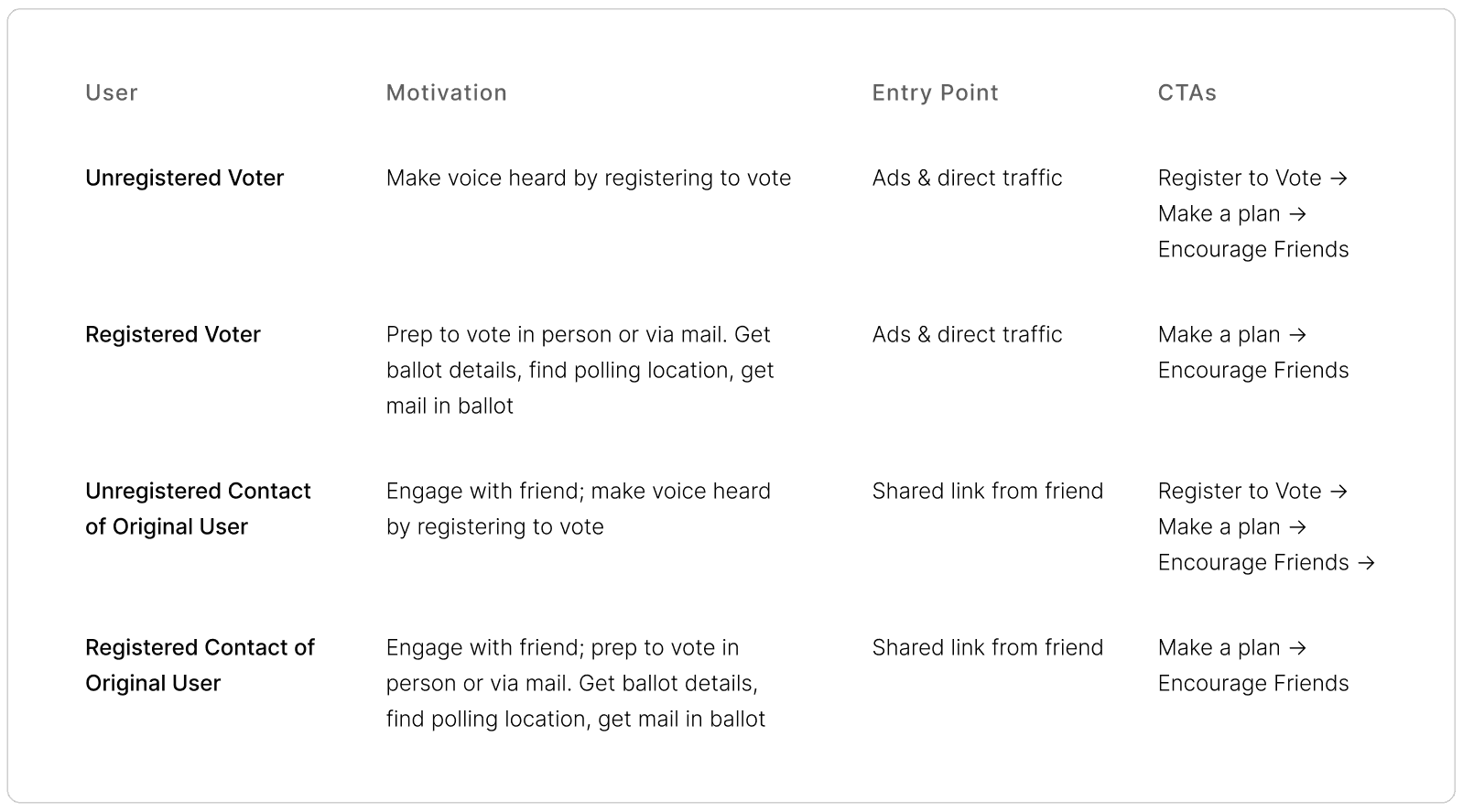


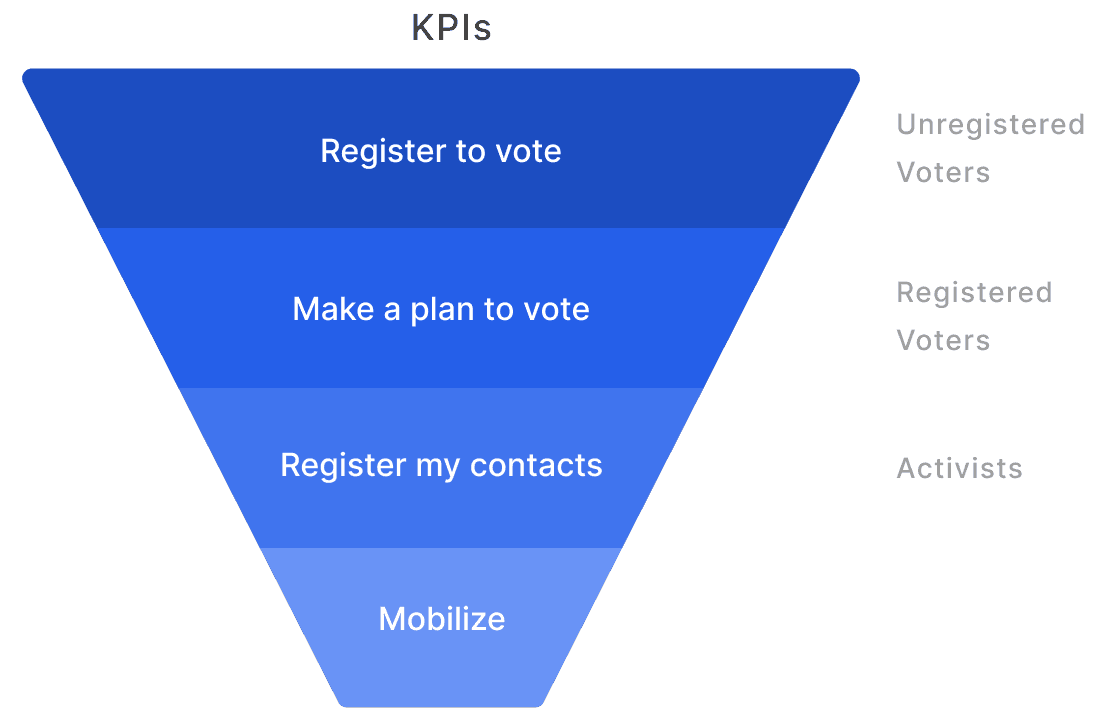


vision
The project vision was to primarily target unregistered voters with the goal of getting them registered. Once registered, we would guide them to make a plan to vote by assisting them in finding their polling location and obtaining their ballot details.
After making a vote plan, we would ask them to pay it forward by checking their friends' and family's registration status and encouraging those contacts to register to vote or make a vote plan.
Finally, leading up to the election, we would mobilize all of those people by encouraging them to cast their vote.
early designs
site maps
I began ideating with rough sketches and developed the information architecture for the logged in and logged out states.
People would mostly land on the site's home landing page via ads or a shared link from a friend. Once in the site there would be sections user's could explore:
Why Vote - laying out all the importance for them to vote
About - more information about this initiative and ACRONYM
My Contacts - a location for users to keep track of the contacts they have checked registration for and relevant details about those contacts
I began ideating with rough sketches and developed the information architecture for the logged in and logged out states.
People would mostly land on the site's home landing page via ads or a shared link from a friend. Once in the site there would be sections user's could explore:
Why Vote - laying out all the importance for them to vote
About - more information about this initiative and ACRONYM
My Contacts - a location for users to keep track of the contacts they have checked registration for and relevant details about those contacts
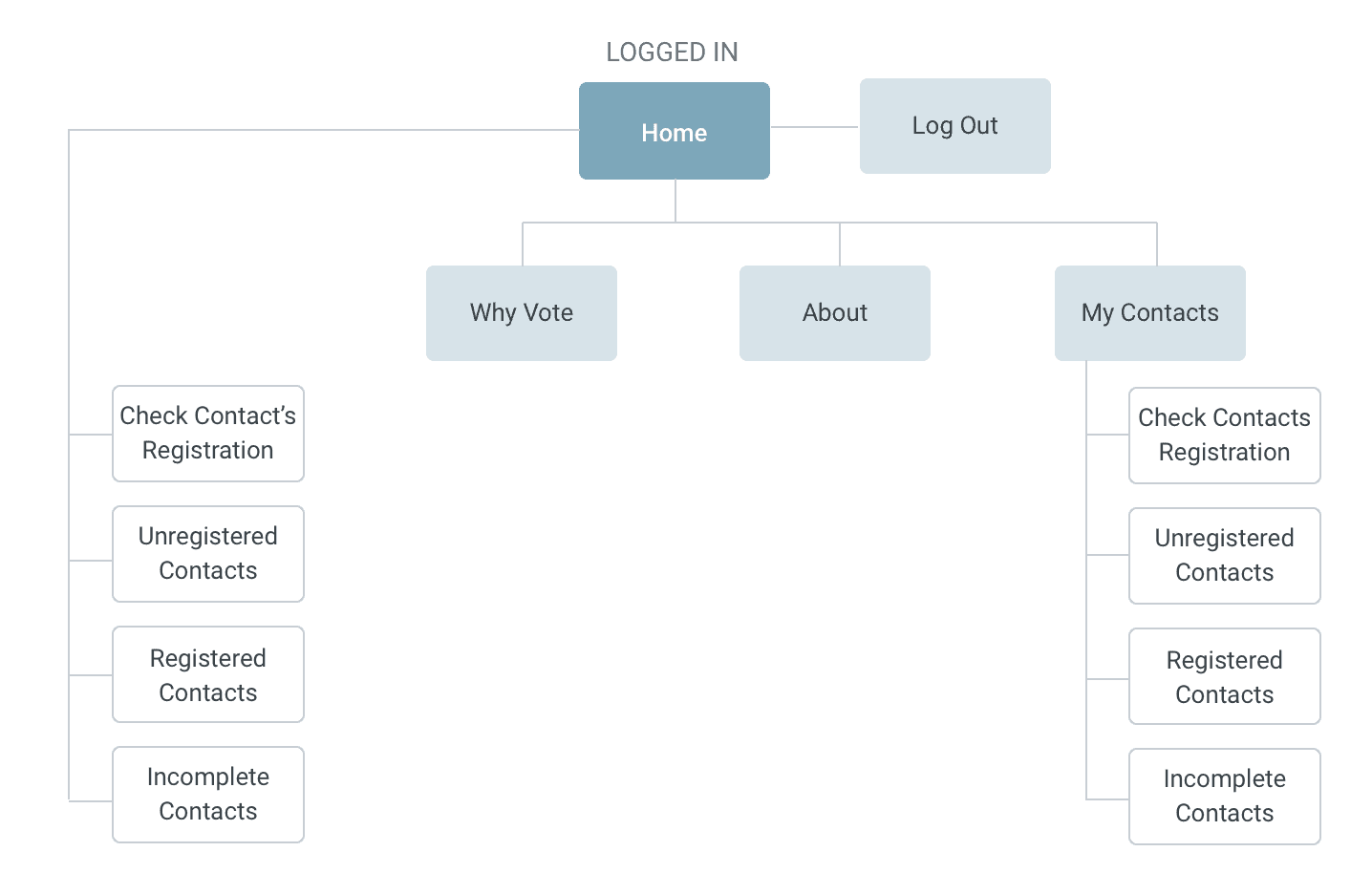





user flows
I developed multiple flows based on the various entry points of the different users. I designed flows for:
Users entering the landing page from social media ads, which is the initial, primary flow (see image below).
Users entering the site via a shared link from a friend. If they are not registered to vote, this link takes them to a voter registration form. If they are registered to vote, the link navigates them to make a plan to vote.
Existing users retargeted with ads closer to the election. They are taken to a landing page which encourages them to cast their vote and to reach out to previously added friends and family to encourage them to do the same.
I developed multiple flows based on the various entry points of the different users. I designed flows for:
Users entering the landing page from social media ads, which is the initial, primary flow (see image below).
Users entering the site via a shared link from a friend. If they are not registered to vote, this link takes them to a voter registration form. If they are registered to vote, the link navigates them to make a plan to vote.
Existing users retargeted with ads closer to the election. They are taken to a landing page which encourages them to cast their vote and to reach out to previously added friends and family to encourage them to do the same.
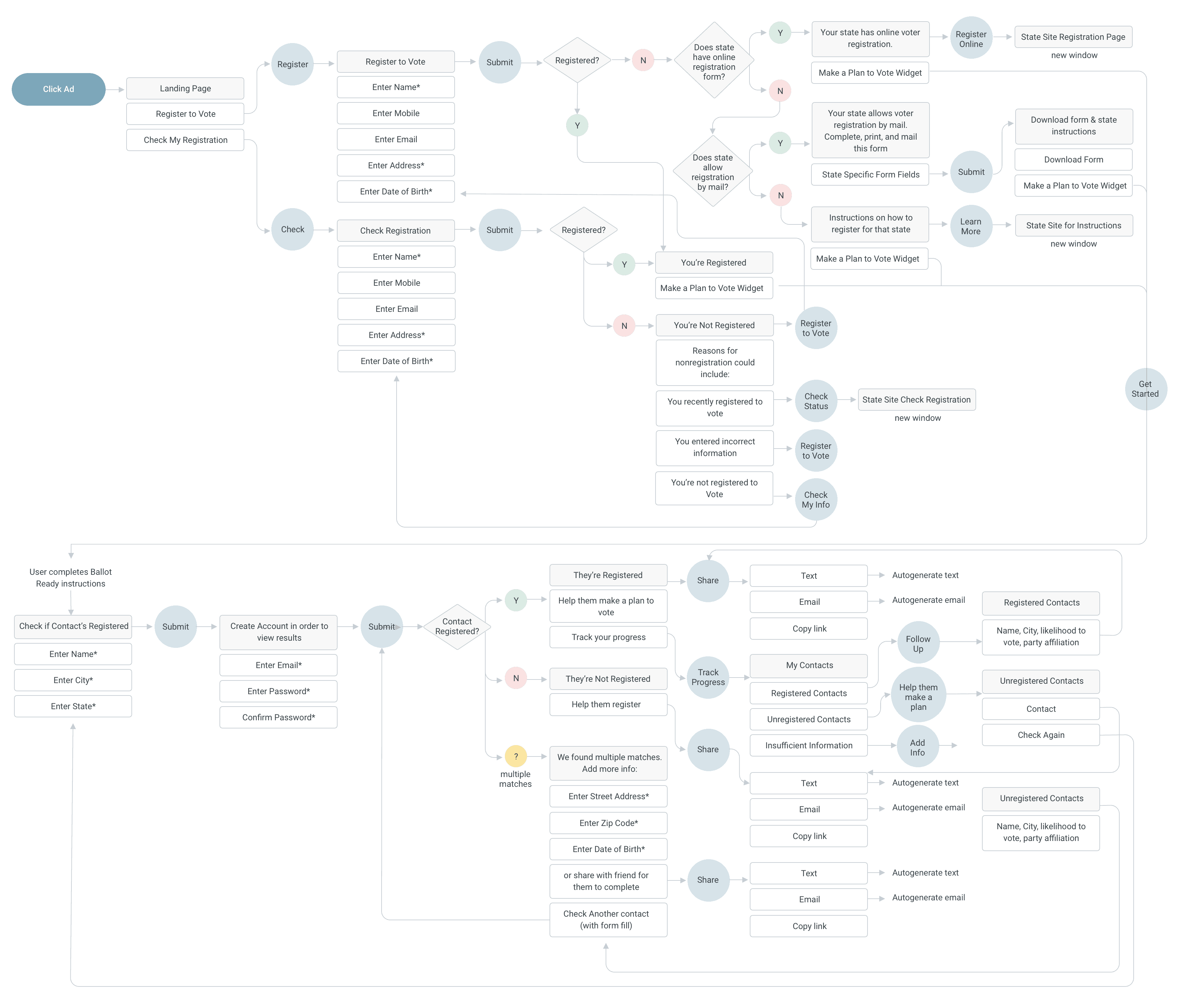


wireframes
I created low-fidelity wireframes and prototypes to user test and get stakeholder feedback on the designs.
I created low-fidelity wireframes and prototypes to user test and get stakeholder feedback on the designs.
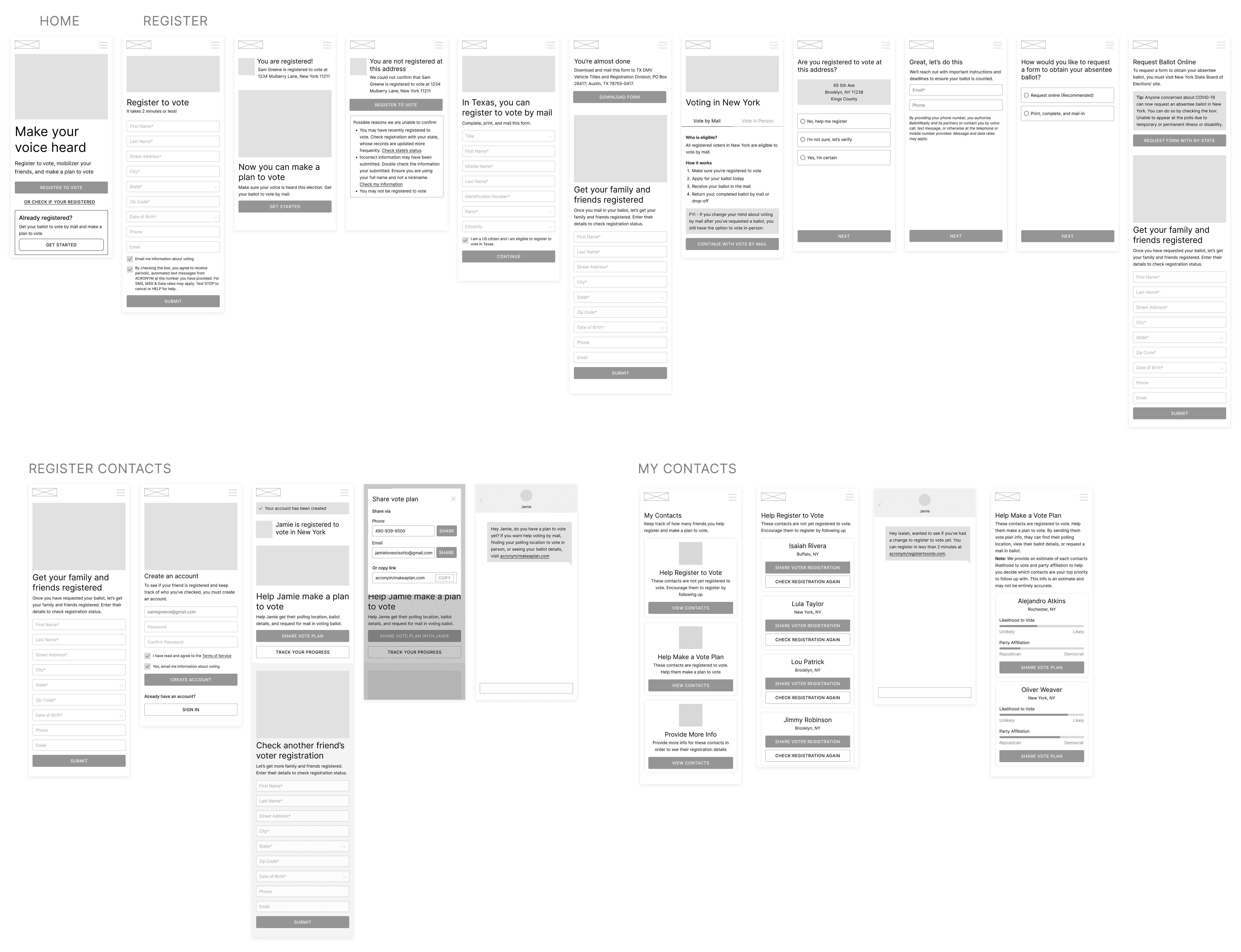


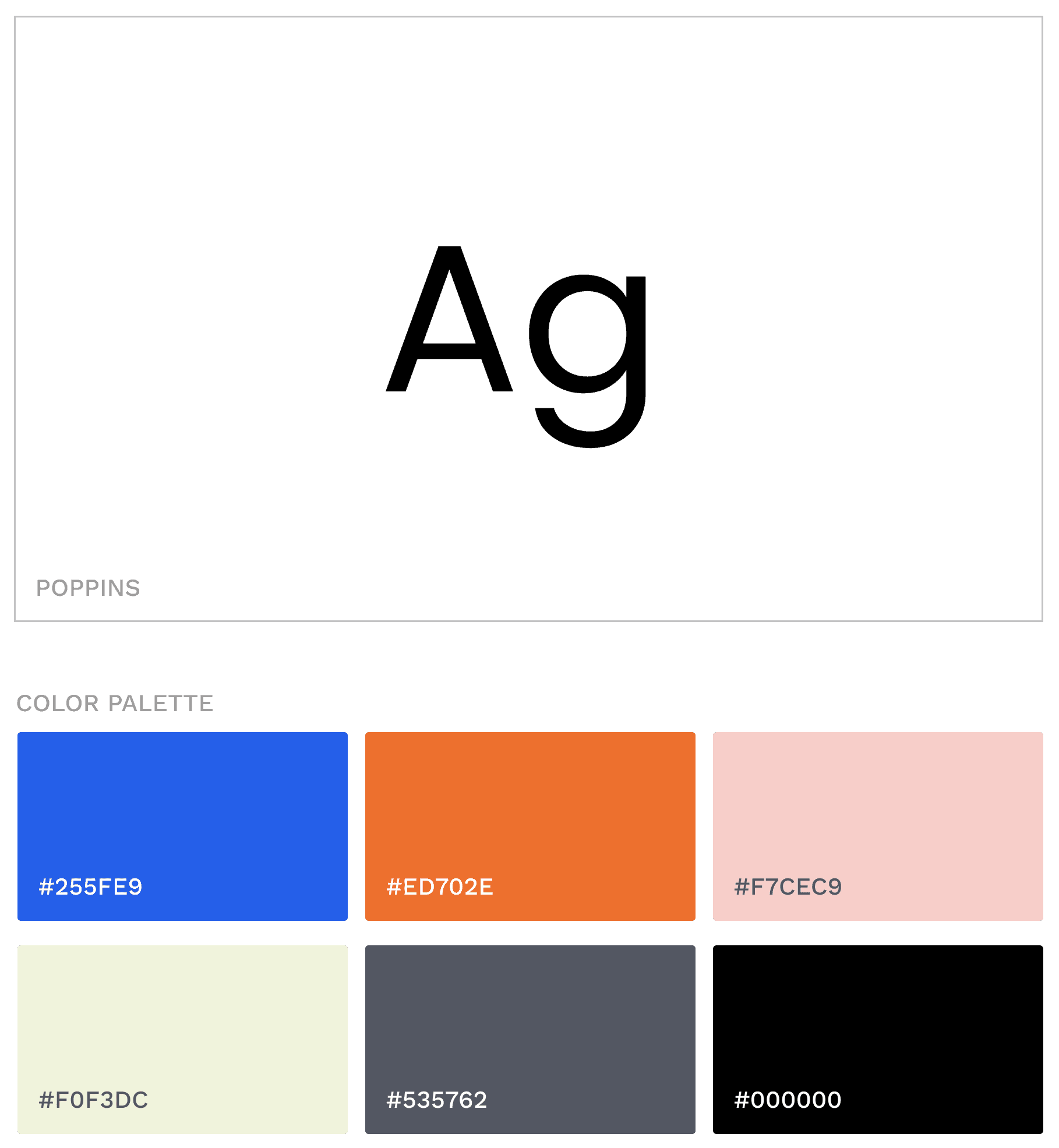


BRANDING AND UI GUIDELINES
I chose Poppins, an approachable, contemporary typeface.
In brainstorming illustrations, I discovered I would need to include many elements which would rely on the red-white-blue color scheme to convey meaning. I opted for variations of the classic blues and reds, and incorporated a pink and yellowish-cream.
illustrationS
Through illustration, I communicated actions associated with the voting process. Given the target audience of the campaign, I incorporated a diversity of people into the illustrations.
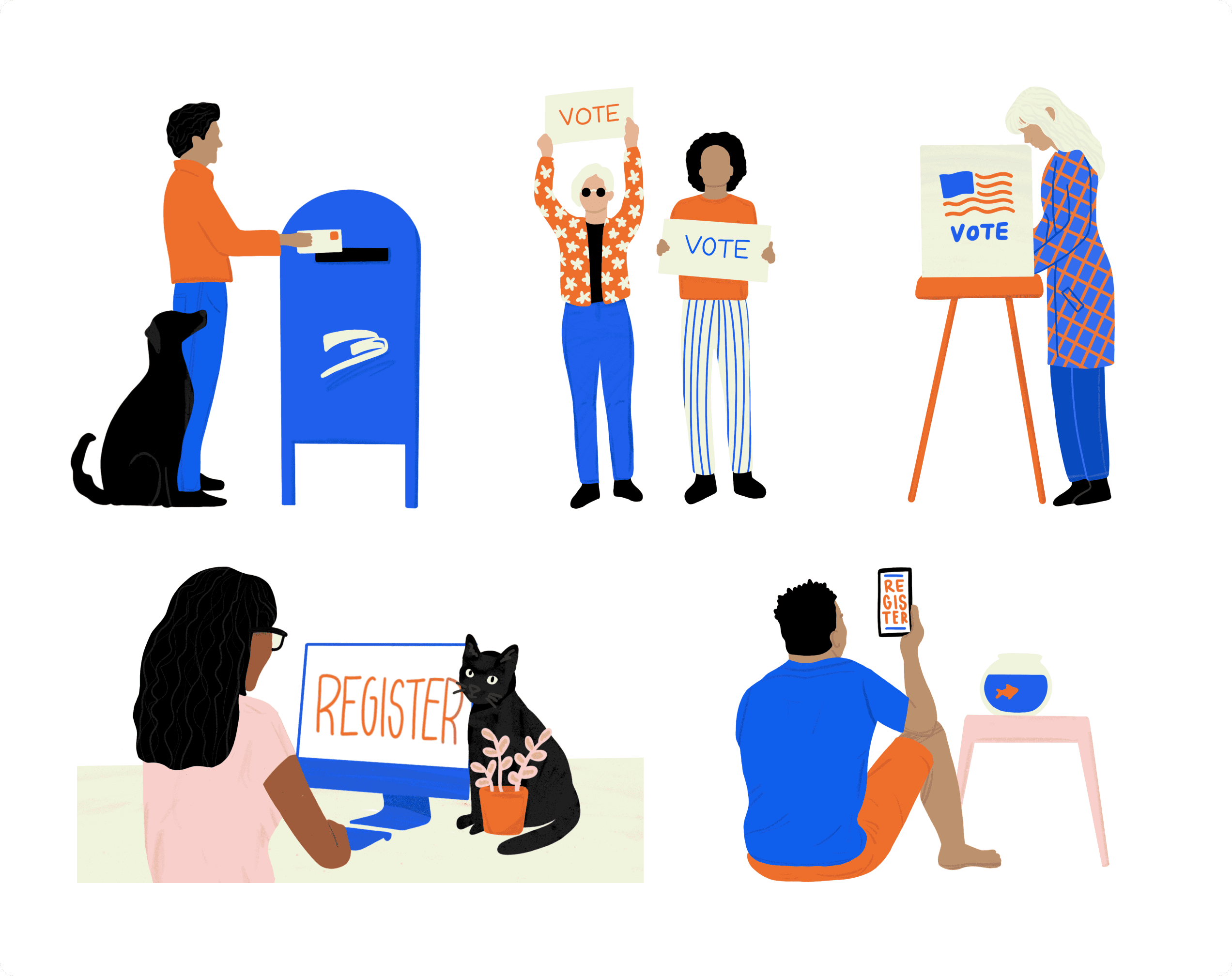


high fidelity designs
register to vote
Upon entering the landing page, users are first and foremost encouraged to register to vote. They also have the option to check if they are already registered. If they are already registered to vote, they can make a plan to vote.
If they choose to register to vote, we guide them through the process of registering based on their state's requirements.
Upon entering the landing page, users are first and foremost encouraged to register to vote. They also have the option to check if they are already registered. If they are already registered to vote, they can make a plan to vote.
If they choose to register to vote, we guide them through the process of registering based on their state's requirements.
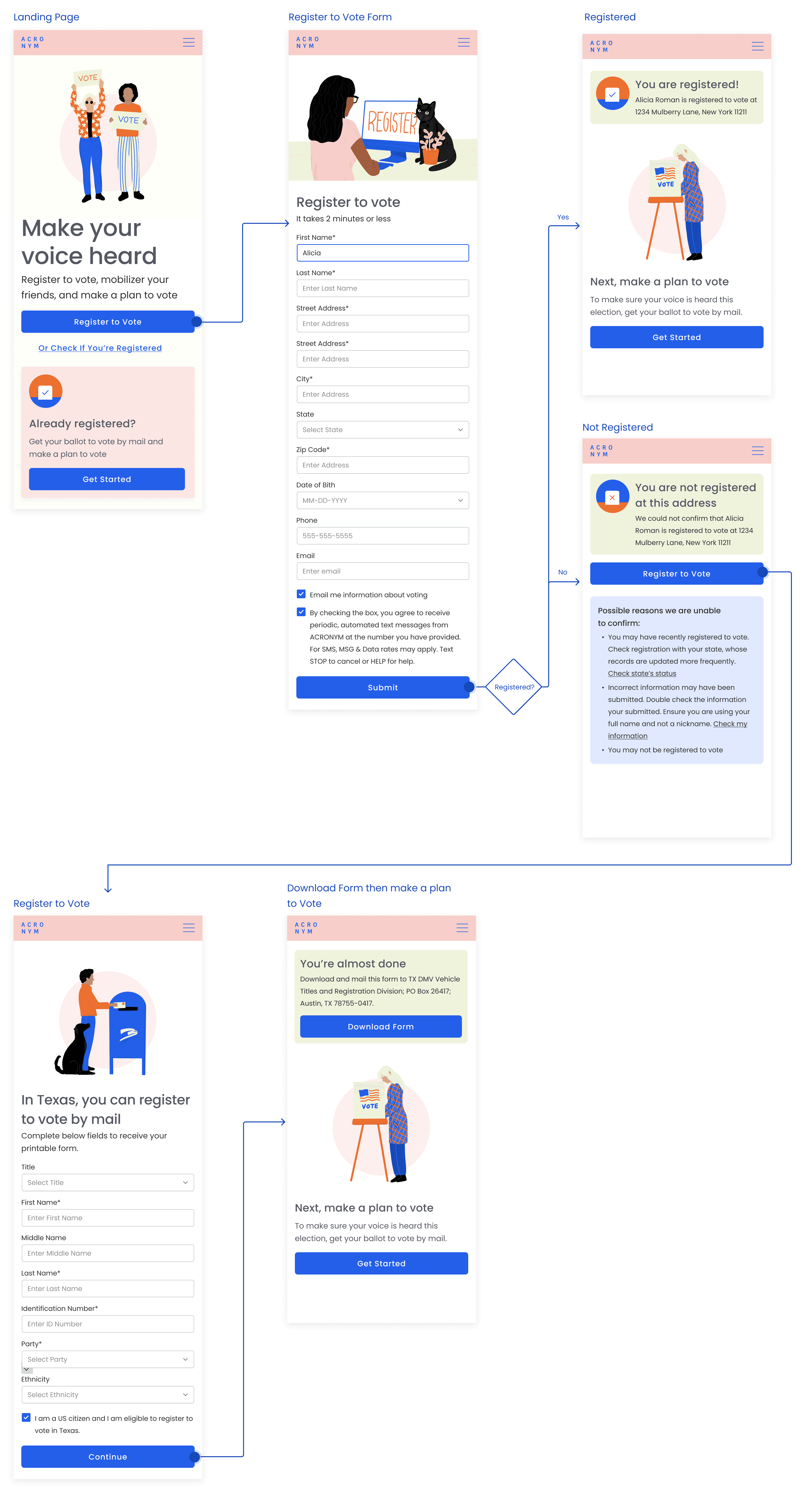


make a plan to vote
Once registered to vote, users are directed to make a plan to vote. Using their address, the system provides them with their polling location, ballot details, and request for mail in voting ballot.
Once registered to vote, users are directed to make a plan to vote. Using their address, the system provides them with their polling location, ballot details, and request for mail in voting ballot.
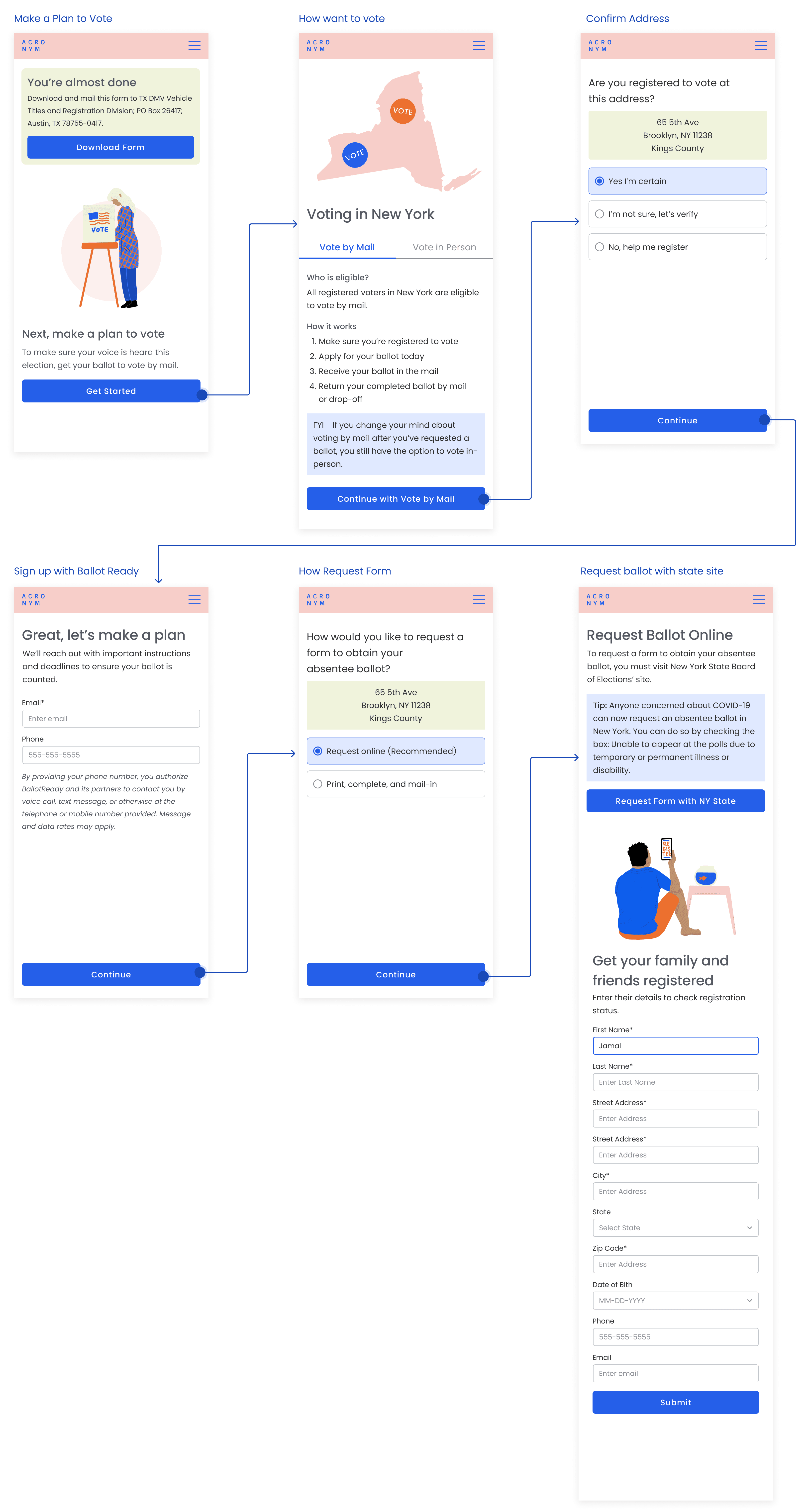


encourage friends to register and vote
After making a plan to vote, the user is encouraged to get people in their social network registered to vote. It's been shown that people are more likely to take action if someone they know is reaching out to them versus a stranger.
If the user's contact is already registered, the user can share a link to "make a plan to vote" with them. If the contact is unregistered, the user can share the contact's pre-filled check registration form with them. The contact can then verify their details within the form and continue the voter registration process for themselves.
After a user checks their contact's registration status, they are prompted to check the status of another friend or family member, which continues in a perpetual loop.
After making a plan to vote, the user is encouraged to get people in their social network registered to vote. It's been shown that people are more likely to take action if someone they know is reaching out to them versus a stranger.
If the user's contact is already registered, the user can share a link to "make a plan to vote" with them. If the contact is unregistered, the user can share the contact's pre-filled check registration form with them. The contact can then verify their details within the form and continue the voter registration process for themselves.
After a user checks their contact's registration status, they are prompted to check the status of another friend or family member, which continues in a perpetual loop.
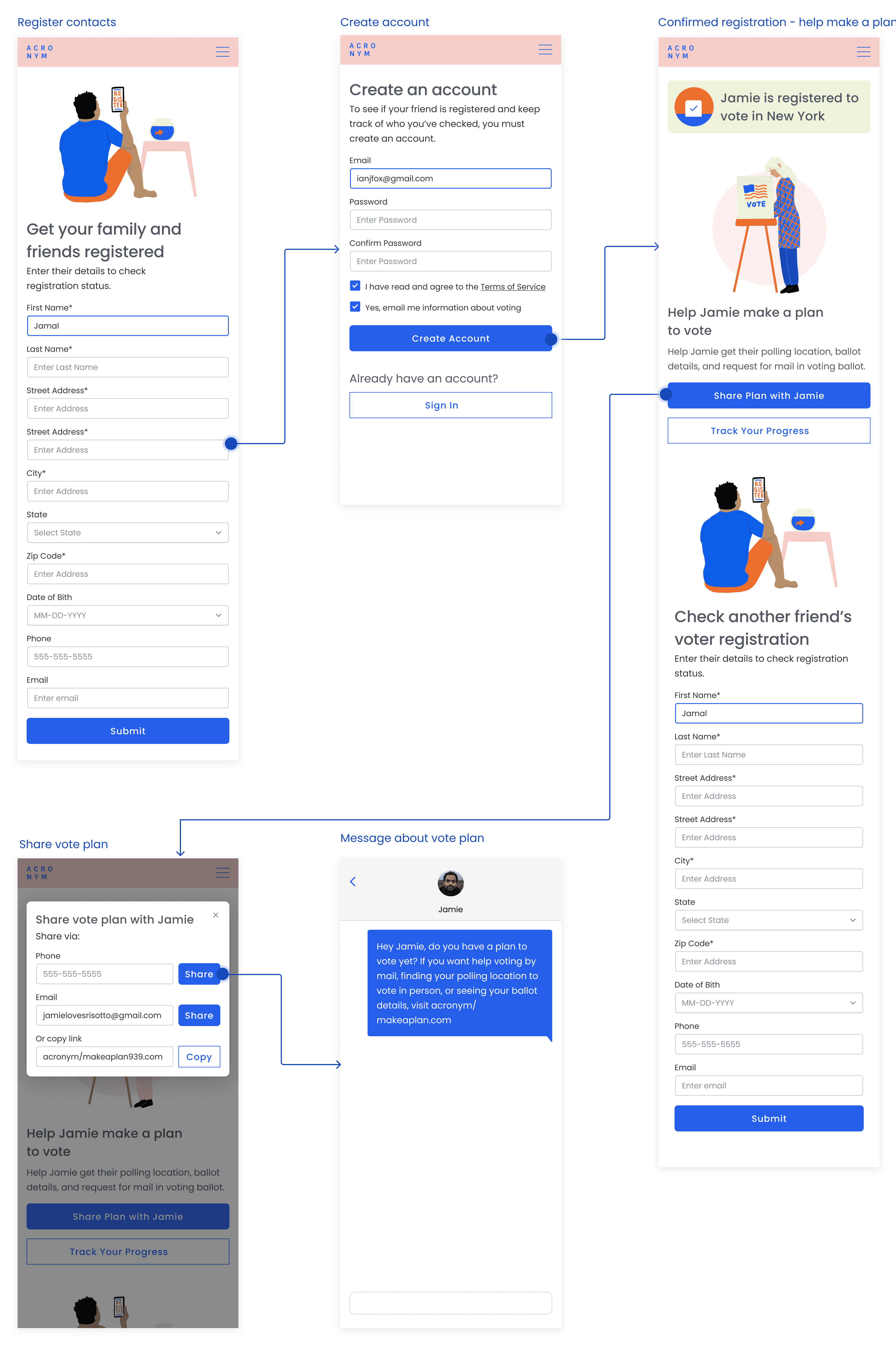


tracking progress
At any point, users can track the progress of their mobilization efforts by viewing all of the contacts they've checked voter registration status for. On these pages, users can view whether those contacts are now registered, unregistered, or unverified due to insufficient information.
For unregistered contacts, users are provided the opportunity to reach back out to them to encourage registration. For registered contacts, users can follow up to motivate them to make a plan to vote. Within each registered contact, we provide the voter's likelihood to vote and party affiliation, in order to help inform the user’s messaging strategy.
At any point, users can track the progress of their mobilization efforts by viewing all of the contacts they've checked voter registration status for. On these pages, users can view whether those contacts are now registered, unregistered, or unverified due to insufficient information.
For unregistered contacts, users are provided the opportunity to reach back out to them to encourage registration. For registered contacts, users can follow up to motivate them to make a plan to vote. Within each registered contact, we provide the voter's likelihood to vote and party affiliation, in order to help inform the user’s messaging strategy.
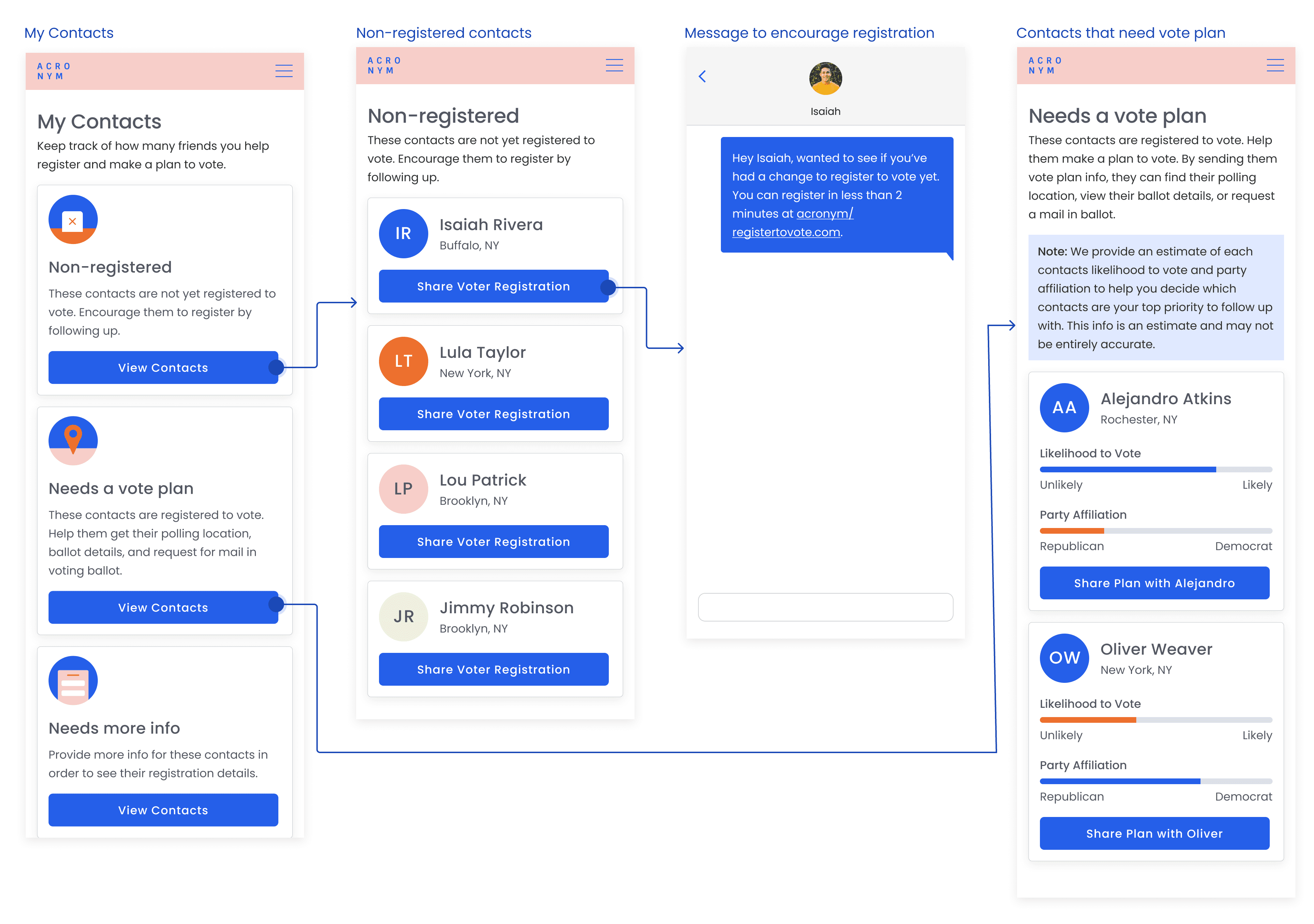


outcome
In 2020, this program has generated roughly 38,000 online registrations and 7,300 make a plan to vote completions.
In 2020, this program has generated roughly 38,000 online registrations and 7,300 make a plan to vote completions.